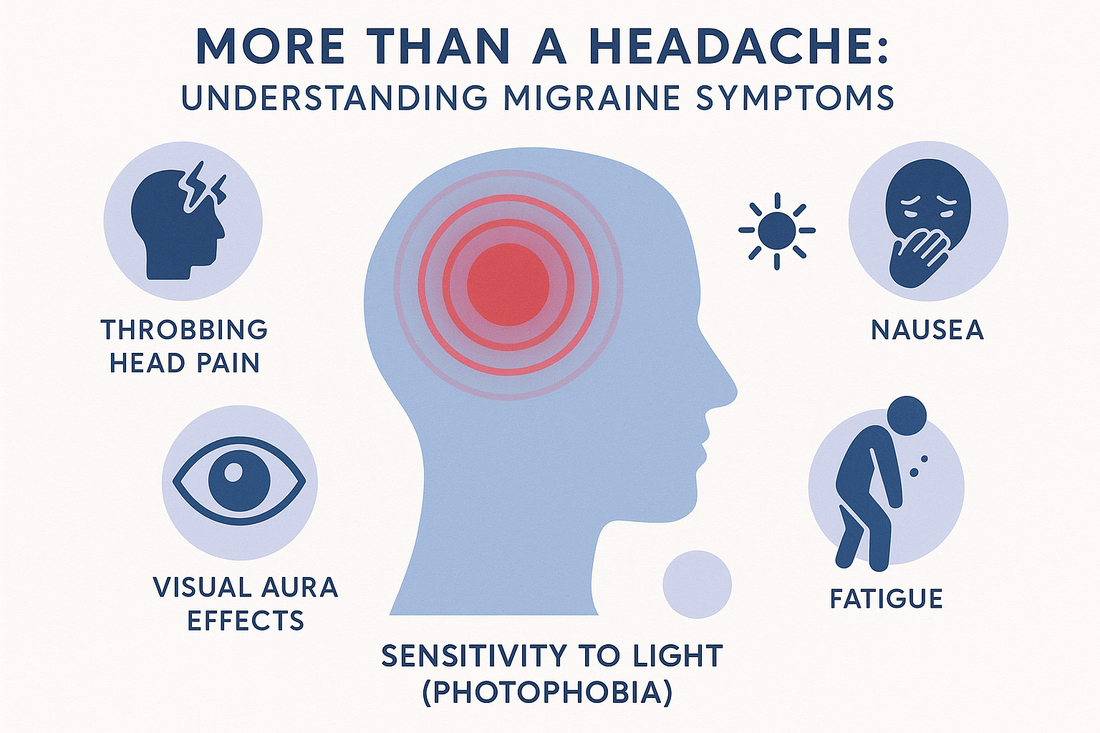
More Than a Headache: Understanding Migraine Symptoms
Share
Disclaimer: This blog post is for informational and educational purposes only. The information provided is not a substitute for professional medical advice, diagnosis, or treatment. Always seek the advice of your physician or another qualified health provider with any questions you may have regarding a medical condition.
Migraines are often mistaken for severe headaches, but they are a complex neurological condition that can be truly debilitating. A migraine attack can involve a range of symptoms far beyond head pain, affecting your senses, mood, and daily life. Recognizing these symptoms is the first step toward finding relief and managing your condition. Here are the key signs to watch for.
1. The Defining Headache

The most recognizable symptom is the head pain itself. Unlike a tension headache, a migraine headache is often described as a throbbing or pounding sensation. The pain can be moderate to severe and is typically concentrated on one side of the head, though it can shift to the other side or affect the entire head. The pain can get worse with physical activity, making even simple tasks feel impossible.
2. Aura: A Warning Before the Storm

For some people, a migraine is preceded by an "aura"—a series of sensory disturbances that act as a warning sign. These typically occur 10 to 30 minutes before the head pain begins. The most common auras are visual:
-
Seeing bright spots, flashes of light, or zig-zag lines.
-
Having a temporary blind spot or partial vision loss.
Aura can also involve other sensory changes, such as numbness or tingling in the face or hands, or difficulty speaking.
3. Extreme Sensory Sensitivity

During a migraine attack, your senses can feel heightened and overwhelming. This is a tell-tale sign that it's more than just a regular headache.
-
Photophobia (Light Sensitivity): Bright or flickering lights can become unbearable, and many people seek out a dark room for relief.
-
Phonophobia (Sound Sensitivity): Normal sounds like a television or a conversation can seem painfully loud.
-
Osmophobia (Smell Sensitivity): Certain smells, even pleasant ones, can trigger or worsen the pain.
4. Other Debilitating Symptoms
The migraine experience often includes a host of other symptoms that can leave you feeling completely unwell.
-
Nausea and Vomiting: Many people feel nauseous or may even vomit during a migraine, especially if the pain is severe.
-
Fatigue and Mood Changes: Leading up to or after an attack, you might feel unusually tired, irritable, or have a general change in mood.
-
Dizziness or Lightheadedness: Some individuals report feeling dizzy or having a sense of vertigo.

A Natural Solution for Relief: Nevilife Essential Oil for Migraine

While managing migraines requires a comprehensive approach with professional medical guidance, natural remedies can provide a complementary source of relief. The Nevilife Essential Oil for Migraine offers a soothing, natural option made from 100% herbal oil extracts.

This unique blend of Peppermint Oil and Rosemary Oil is designed to provide targeted relief. Peppermint oil, rich in menthol, helps relax muscles and can ease pain, while rosemary oil is known for its anti-inflammatory and pain-relieving properties. The product works by preventing pressure on the sensory nerves that cause migraine headaches. Simply apply it to your forehead and the top of your head once a day for a calming effect.
Click here to explore the soothing benefits of Nevilife Essential Oil for Migraine!